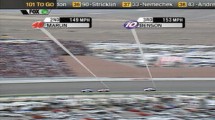Abstract
Accurate 3D registration is a key issue in the Augmented Reality (AR) applications, particularly where are no markers placed manually. In this paper, an efficient markerless registration algorithm is presented for both outdoor and indoor AR system. This algorithm first calculates the correspondences among frames using fixed region tracking, and then estimates the motion parameters on projective transformation following the homography of the tracked region. To achieve the illumination insensitive tracking, the illumination parameters are solved jointly with motion parameters in each step. Based on the perspective motion parameters of the tracked region, the 3D registration, the camera’s pose and position, can be calculated with calibrated intrinsic parameters. A marker-less AR system is described using this algorithm, and the system architecture and working flow are also proposed. Experimental results with comparison quantitatively demonstrate the correctness of the theoretical analysis and the robustness of the registration algorithm.











Similar content being viewed by others
References
Azuma R, Hoff B, Neely H (1999) A motion-stabilized outdoor augmented reality system. Proc IEEE Virtual Reality, Los Alamitos. IEEE, California, pp 252–259
Azuma R, Baillot Y et al (2001) Recent advances in augmented reality, computer graphics and applications. IEEE Comput Graph Appl 21(6):34–47 doi:10.1109/38.963459
Bajura M, Henry F, Ohbuchi R (1992) Merging virtual reality with the real world: seeing ultrasound imagery within the patient. Proceedings of SIGGRAPH'92 (Chicago, IL). Comput Graph (ACM) 26(2):203–210 doi:10.1145/142920.134061
Behringer R (1999) Registration for outdoor augmented reality applications using computer vision techniques and hybrid sensors. Proc IEEE Virtual Real 13–17:244–251 (March)
Black MJ, Jepson AD (1998) Eigentracking: robust matching and tracking of articulated objects using a view-based representation. Int J Comput Vis 26(1):63–84 doi:10.1023/A:1007939232436
Bobick AF, Wilson AD (1995) A state-based technique for the summarization of recognition of gesture. Proc. Proceedings of International Conference on Computer Vision, 382–388
Chen J, Shi Q, Wang Y (2001) AR technology and applications. Comput Engineer Application 37(21):55–57
Darrell T, Moghaddam B, Pentland A (1996) Active face tracking and pose estimation in an interactive room. Proceedings of IEEE Conf. Computer Vision and Pattern Recognition 67–72
Dorfmuller K (1999) Robust tracking for augmented reality using retroreflective markers. Comput Graph 23(6):795–800 doi:10.1016/S0097-8493(99)00105-3
Hager GD, Bellumeur PN (1996) Real-time tracking of image regions with changes in geometry and illumination. Proceedings of the IEEE Conference on Computer Vision and Pattern Recognition 403–410
Hu X, Liu Y, Wang Y (2005) Autocalibration of an electronic compass for augmented reality. Proc of IEEE and ACM International Symposium on Mixed and Augmented Reality (ISMAR) 1:182–183
Hutchinson S, Hager GD, Corke P (1996) A tutorial introduction to visual servo control. IEEE Trans Robot Autom 12(5):651–670 doi:10.1109/70.538972
Jafari S, Jarvis R (2005) Robotic eye-to-hand coordination: implementing visual perception to object manipulation. Int J Hybrid Intell Syst 2(4):269–293
Kutulakos KN, Vallino JR (1998) Calibration-free augmented reality. IEEE Trans Vis Comput Graph 4(1):1–20 doi:10.1109/2945.675647
La Cascia M, Sclaroff S, Athitsos V (2000) Fast, reliable head tracking under varying illumination: an approach based on registration of textured-mapped 3D models. IEEE Trans Pattern Anal Mach Intell 22(4):322–336 doi:10.1109/34.845375
Li X, Liu Y, Wang Y et al (2005) An improved colored-marker based registration method for AR applications. Lect Notes Comput Sci 3482:266–273
Li Y, Wang Y, Liu Y (2007) Fiducial marker based on projective invariant for augmented reality. J Comput Sci Technol 22(6):890–897 doi:10.1007/s11390-007-9100-0
Lin L, Liu Y, Zheng W, Wang Y (2006) Registration algorithm based on image matching for outdoor AR system with fixed viewing position. IEE Proc, Vis Image Signal Process 153(1):57–62 doi:10.1049/ip-vis:20045181
Okuma T, Sakaue K, Takemura H, Yokoya N (2000) Real-time camera parameter estimation from images for a mixed reality system. Proc Int Conf Pattern Recognit 4:4482–4486
Ribo M, Pinz A, Fuhrmann A (2001) A new optical tracking system for virtual and augmented reality applications. Instrum Meas Tech Conf 3:1932–1936
Shi J, Tomasi C (1994) Good features to track. In IEEE Computer Society Conference on Computer Vision and Pattern Recognition (CVPR'94), 593–600
Tang S-L, Kwoh C-K et al (1998) Augmented reality systems for medical applications. Eng Med Biol Mag 17(3):49–58 doi:10.1109/51.677169
Uenohara M, Kanade T (1995) Vision-based object registration for real-time image overlay. Int J Comput Biol Med 25(2):249–260 doi:10.1016/0010-4825(94)00045-R
You S, Neumann U (2001) Fusion of vision and gyro tracking for robust augmented reality registration. Proc IEEE Virtual Real 2001:71–78 doi:10.1109/VR.2001.913772
Zagoranski S, Divjak S (2003) Use of augmented reality in education, EUROCON 2003, Computer as a Tool, The IEEE Region 8, 22–24 Sept. 2003, Vol. 2: 339–342
Acknowledgements
This project is supported by National Basic Research Program of China (National 863 Program, Grant No. 2006AA01Z339), National Natural Science Foundation of China (Grant No. 60673198), and China Postdoctoral Science Foundation funded project (Grant No. 20080430313). The author would like to thank Ke Yang for contributive comments and assistance in experiments.
Author information
Authors and Affiliations
Corresponding author
Rights and permissions
About this article
Cite this article
Lin, L., Wang, Y., Liu, Y. et al. Marker-less registration based on template tracking for augmented reality. Multimed Tools Appl 41, 235–252 (2009). https://doi.org/10.1007/s11042-008-0227-y
Published:
Issue Date:
DOI: https://doi.org/10.1007/s11042-008-0227-y




